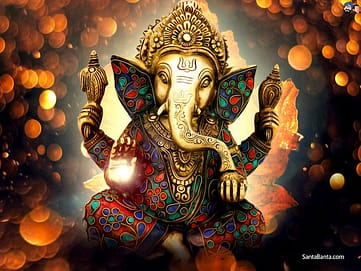 Ganesha is the Ever-Blissful, elephant-headed deva (god) who is lovingly worshipped and revered by millions of people worldwide. The son of Shiva and Parvati, Shree Ganesha, is the God of Good Luck and Auspiciousness and is the Dispeller of problems and obstacles. He is also worshipped as the God of wisdom, wealth, health, fertility and happiness. One of the most anticipated and lively festivals in India, Ganesha Chaturthi (1st September 2011) is dedicated to the beloved elephant-headed god, Ganesha.
Ganesha is the Ever-Blissful, elephant-headed deva (god) who is lovingly worshipped and revered by millions of people worldwide. The son of Shiva and Parvati, Shree Ganesha, is the God of Good Luck and Auspiciousness and is the Dispeller of problems and obstacles. He is also worshipped as the God of wisdom, wealth, health, fertility and happiness. One of the most anticipated and lively festivals in India, Ganesha Chaturthi (1st September 2011) is dedicated to the beloved elephant-headed god, Ganesha.
Vakratunda Mahakaya Surya Koti Samaprabha
Nirvighnam Kurumeydeva Sarva Karyeshu Sarvada
“O Lord Ganesha of Large Body,
Curved Trunk,
With the Brilliance of a Million Suns,
Make All My Work Free Of Obstacles,
Always.”
As we bring home his idol on this very day, we are also urged to bring along the qualities embodied by him and his form. As with all of the Hindu deities, the symbolism of Ganesha is multi-layered and profound. Each part and element of his body has its own significance and meaning.
Symbolism of Lord Ganesha
Elephant Head
The elephant head of Lord Ganesha is symbolic of His eternal Wisdom. It also denotes His intelligence and discriminative powers.
Wide Ears
His huge fan like ears of an elephant depict wisdom, ability to listen to people who seek help and to reflect on spiritual truths. Ears are used to gain knowledge. Large ears indicate that when God is known, all knowledge is known.
Single Tusk
(The other being broken off) indicates Ganesha’s ability to overcome all forms of dualism. The broken tusk primarily indicates his ability to “break-through” the illusions of duality. It also portrays sacrifice which commemorates the significance of the Lord breaking His tusk to write the scripture (Mahabharata) while sage Vyasa dictated it for common good.
The Trunk
The curved trunk of Lord Ganesha depicts discrimination between real and unreal which is one of the most important aspect for enlightenment.
Pot belly
The pot belly of Ganesha denotes the limitless space which contains infinite universes and wisdom and knowledge. It signifies bounty of nature and the ability of Ganesha to swallow the sorrows of the Universe and protect the world.
Four arms
The four arms of Ganesha represent the four attributes of the subtle body – mind (Manas), intellect (Buddhi), ego (Ahamkara) and conscience (Chitta). His right arm holds an axe or a cutter, a rope or a noose is held in His left arm, a sweet modak in his lower left arm and the lower right hand portrays the hand that showers blessings.
The axe removes the duality and cuts away the materialistic bonding. The noose or the rope cautions one against the entanglement in Maya or illusion and urges man on the path of righteousness and truth. The Modak (Sweet) represents the sweetness of enlightenment and the hand that shows the sign of blessing promises protection and refuge.
Position of Legs
Ganesha is shown sitting with one foot on the ground and the other resting on his knee, above the ground. It indicates the importance of living and participating in the material world as well as in the spiritual world; the ability to live in the world without being of the world.
The Mouse
The mouse which is the vehicle of Lord Ganesha represents the ego and senses of man. Rat is among the greediest of all animals. It will keep nibbling at whatever is available, eating everything it can. Scientifically, too, the rat’s teeth keep growing and it has to keep chewing on something to keep these within limits. The rat is a symbol of our senses, which are never satisfied. They crave new experiences, new tastes. Left uncontrolled, they keep growing forever. The wise person rides on his senses. He keeps them under control. The mouse lies at the feet of the Lord to represent the Lord’s victory over it and also holds the truth that the supreme reins the ego.
Myths and legends
Each Purana narrates a different story of the birth of Lord Ganesha. This version follows the Shiva- Purana.
One day Goddess Parvati was at home on Mt.Kailash preparing for a bath. As she didn’t want to be disturbed, she told Nandi, her husband Shiva’s Bull, to guard the door and let no one pass. Nandi faithfully took his post, intending to carry out Parvati’s wishes. But, when Shiva came home, Nandi had to let him pass, being loyal first to Shiva. Parvati was angry at this slight, but even more than this, at the fact that she had no one as loyal to her as Nandi was to Shiva. So, taking the turmeric paste (for bathing) from her body and breathing life into it, she created Ganesha, declaring him to be her own loyal son.
Parvati ordered Ganesha not to allow anyone to enter the house and Ganesha obediently followed his mother’s orders. The Goddess then proceeded to take her bath. At that time, Lord Shiva returned and as he tried to enter the house, Ganesha stopped him. Shiva was infuriated at this strange little boy who dared to challenge him. He told Ganesha that he was Parvati’s husband and demanded that Ganesha let him go in. But Ganesha would not hear of it, saying that he will follow only his mother’s orders.
Shiva lost his patience and had a fierce battle with Ganesha. In his anger, Lord Shiva severed Ganesha’s head. When Parvati came out and saw her son’s lifeless body, she was furious. She demanded that Shiva restore Ganesha’s life at once. She created innumerable Shaktis (forms of herself) and ordered them to devour all the Gana (celestial armies) and Deva (Gods). Absolutely terrified, Brahma and Vishnu begged for her; in exchange, Parvati demanded that her son be revived, she also asked that her son be worshipped first, before all other gods.
Hence, in all Hindu prayers, offerings are done for Lord Ganesha before other gods.
Shiva sent his Ganas (celestial troops) out with orders to bring back the head of the first creature they crossed that lay with its head facing north. They soon returned with the head of a strong and powerful elephant, which Shiva placed onto Ganesha’s body. Breathing new life into him, he declared Ganesha to be his own son as well, and gave him the status of being foremost among the gods, and leader of all the Ganas (classes of beings), Ganapati.
Ganesha is also believed to have been the legendary scribe who wrote down the text of the Indian Epic Mahabharata as it was recited by the sage Ved Vyasa. When the sage asked Ganesha to write down the epic, the playful learned God agreed on condition that his pen should not stop moving until the story was completed i.e. Vyasa must recite the Epic non-stop. Vyasa agreed but imposed a counter-condition that Ganesha understand each verse completely before transcribing it. So whenever Ganesha stopped to consider Vyasa’s complex compositions, the sage would use the time to compose more verses. Thus the great epic of Mahabharata is said to have been written by Lord Ganesha.
Many names of Lord Ganesha
Akhuratha One who has Mouse as His Charioteer
Avighna Remover of Obstacles
Balaganapati Beloved and Lovable Child
Chaturbhuj One who has Four Arms
Devadeva Lord of All Lords
Durja Invincible Lord
Dvaimatura One who has two Mothers
Ekaakshara He, of the Single Syllable
Ekadanta Single-Tusked Lord
Ekadrishta Single-Tusked Lord
Gajanana Elephant-Faced Lord
Ganapati Lord of All Ganas (Gods)
Gaurisuta The Son of Gauri (Parvati)
Mahaganapati Omnipotent and Supreme Lord
Mangalamurti All Auspicious Lord
Omkara One who has the Form of OM
Siddhidhata Bestower of Success and Accomplishments
Siddhipriya Bestower of Wishes and Boons
Siddhivinayaka Bestower of Success
Vakratunda Curved Trunk Lord
Vighnahara Remover of Obstacles
Blessings of Lord Ganesha
Traditionally held to be Ganesha’s birthday, the Ganesha Chaturthi falls on the 4th day of the bright fortnight of Bhadrapada (Hindu Lunar Month) in August-September. It is followed by a week of pujas, bhajans and cultural programs. A clay idol of Ganesha is made and worshipped on all of the festival days with prayers and devotional songs. The festivities culminate with the Ganesha Visarjan, where the idol is carried in a procession to the sea, river, or other large body of water, to be ceremonially immersed. The symbolism of this immersion ceremony reveals that at the heart of worship of different deities there remains the profound understanding that all forms are temporary, having both their origin and final destination in the formless Absolute.
Lord Ganesha is worshipped before starting any work for wisdom, success and removing hurdles. He is also worshipped to remove negative effects of planet Mercury in a native’s horoscope. Those born on 5, 14 or 23 or having number 5 as their life path or destiny number should worship him to use the attributes of number 5 successfully.
It is also believed that any sculpture of Ganesha with his elephantine trunk pointing to the left is used for home decoration, as symbolically it is associated with Grihasthas (Householders) and points to the direction for success in the world. Any image with Ganesha’s trunk pointing to the right is used for worship and prayers, as the direction symbolizes the ultimate path of life: Moksha or Salvation through renunciation of the world. When one chooses a Ganesha sculpture that is proper for their own spiritual path, the position of the trunk is good to keep in mind.
Let us thus celebrate Ganesha Chaturthi realising the inner meaning of the aspects of Lord Ganesha. Let us do away with the binding worldly attachments by freeing ourselves from the noose of illusion with discrimination and vanquish the ego by surrendering to the Lord who promises protection and attain the sweetness of bliss of spiritual enlightenment.


